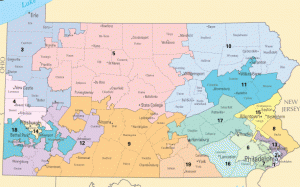Lawmakers Near Final Approval of Congressional Maps
Pennsylvania will lose a Congressional seat in 2012, as the Keystone State’s population growth didn’t keep up with other states over the past ten years. The General Assembly must now act quickly to approve the new congressional maps. “If a congressional redistricting plan is not enacted by the end of this calendar year, it will cause chaos in the 2012 election cycle,” said Senate GOP Leader Dominic Pileggi. During Wednesday night’s Senate debate, Pileggi noted that the process of circulating nominating petitions begins on January 24th.
The Republican-drawn maps were unveiled earlier in the week, cleared the Senate on Wednesday night, and advanced out of the House State Government Committee on Thursday afternoon. Up next is consideration by the full House.
Democrats are lining up to criticize SB 1249 as blatant gerrymandering. “I ask anybody who looks at these maps, are these districts contiguous or are they torturous?” said Rep. Babette Josephs (D-Phila.), the Minority Chair of the House State Government Committee.
Appearing on Radio PA’s monthly Ask the Governor program, Governor Tom Corbett said this is the situation every ten year, no matter which party is in the majority. “It’s incumbent upon the congressmen who represent those districts… to make sure that they pay attention to their constituents no matter where they are.”
Corbett says the process is particularly difficult when one congressional district must be drawn out of existence. In this case, the proposal would combine the districts of Democratic Congressmen Jason Altmire and Mark Critz.
“We knew that the Republicans would use their control of the process to draw a map that that benefitted Republicans, but we did not expect them to abuse their power to this degree,” said Pennsylvania Democratic Chairman Jim Burn.








